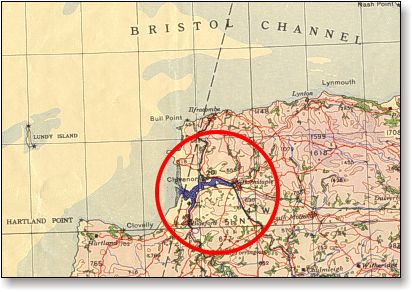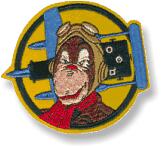Part I

|
We watched unit after unit go through the rugged course, and were smugly congratulating ourselves on our relatively safe situation as the maintenance crew, when, to our consternation, early in May we learned that we were the next unit on the list and that another Engineer outfit would be cleaning up after us.
As engineers who would be landing early on D-Day, we concentrated on the demolition, using explosives, of obstacles, similar to those the Germans had erected on the coast of Normandy. Landing barges were to take us across the English Channel to France, and we invented a little song: "Coming in on a barge with a charge", to the tune of "Coming In On A Wing and a Prayer".
Our Training completed, we were isolated a few days before the invasion in a fenced enclosure --- no passes outside for anybody --- and briefed very thoroughly on that part of Normandy Beach we'd be landing on. For the briefing, we had low- and high-altitude aerial photographs provided by the Air Force's 34th [Photo] Reconnaissance Squadron. There was also an extremely accurate scale model of Omaha Beach, complete with natural features, trees, houses, and other buildings, and even such German military installations as were known to be in the vicinity. We memorized the landing site and studied the obstacles in the photographs until we knew everything backwards and forwards. Later, when we did land, we discovered just how accurate the model had been; the coast looked just like it, right down to the last detail.

|
On the evening of June 4 we sailed out into the English Channel. As far as the eye could see in all directions the sea was filled with landing craft, navy vessels, supply vessels, and other types of military shipping. We woke up on the morning of June 5th .... back in Plymouth! Eisenhower had been compelled to order the armada to turn around and go back because the weather had turned foul and any attempt to land in France would have been foolhardy if not impossible. I still marvel that that vast fleet could be controlled in so efficient, orderly, and precise manner. That evening, the 5th, we sailed again, and consoled one another by saying this was probably another dry run.
It wasn't.
Before dawn on the 6th we rendezvoused with a fleet of small landing craft --- LCP's (Landing Craft Personnel) -- each just large enough to hold a platoon of men, steered by a coxswain from the Coast Guard. We transferred to our LCP at sea, leaving the larger LST with its tank-dozer to come in on its own mission, and began the run to shore. For a few minutes the LCPs ran side-by-side, so close together that we could converse with the people in the neighboring boats; we gradually drew apart, however, spacing out to the prescribed intervals for landing.

|
As we drew near Omaha Beach in the early morning light, we easily recognized the landmarks and features we had seen on the scale model, and were beginning to receive fire from shore. At this distance, shells from German 88's, a very sleek and efficient weapon, were plopping into the sea around us, sending up geysers of spume as they exploded in the water. Some boats, of course, were hit; one unfortunate craft blew up when a shell dropped into it and set off the explosives aboard.
The timing of each phase of enormously complicated "Operation Overlord" had been carefully worked out to the last minute: at H-Hour, M-Minute, the first infantry units were to go ashore; at H-Hour plus five minutes we demolition engineers were to land. As thus scheduled, the infantry would have engaged the enemy, hopefully pushing him back, leaving us free to proceed with our mission without the necessity of defending ourselves.
Ah, the best laid plans of mice and men ....
It happened that we arrived first in our particular sector, at H-Hour, M-Minute, at lowest tide, about 6 or 6:30 a.m. The LCP went aground before we touched shore, and the coxswain told us he could go no further; he was stuck on a sand bar. He lowered the ramp and we saw that we'd have to wade a distance of perhaps 50 or 70 yards to get to the beach. I gave the order to disembark and jumped off the end of the ramp. Well!
The sand bar was under the shallow-draft boat, but it wasn't in front of the ramp. Loaded down with explosives, carbines, binoculars. prima-cord, and what-all, we sank like stones. Fortunately, the water was only up to our necks; fortunately also, there was very little wave action, and we started to wade in.
The spatter pattern of a cone of machine gun fire was hitting the water's surface off to our right, and we detoured to the left in order to give it as wide a berth as possible. That cone of fire never moved closer to us, to our relief, and we all made it to the beach intact, where we immediately set to work amid the THUNK of exploding mortar shells and the whistle of small arms bullets.
The intensive training grind we had gone through so recently tended to make robots of us; we could think of nothing but the tasks we were assigned to carry out, and working under withering fire was something we had never experienced before. It was all so very unreal. One of our men had been a goof-off and a thorn in our flesh throughout his time in the outfit; he had even tried to climb over the the fence in the sealed-off final briefing area to go to town. But here, when the chips were down, he was as calm as if he were in his own backyard at home, going about his assigned duties completely ignoring the danger, as if it were a commonplace thing to work under desperate conditions.
